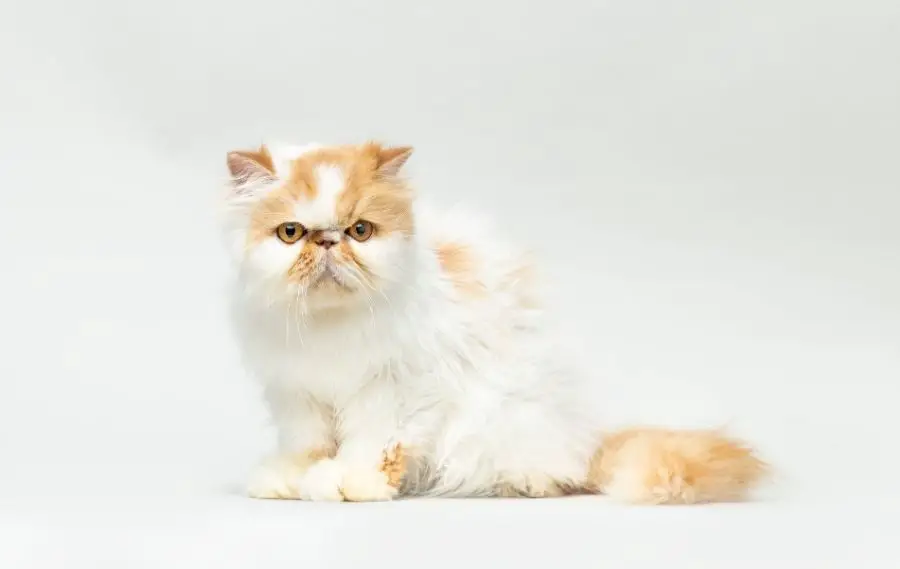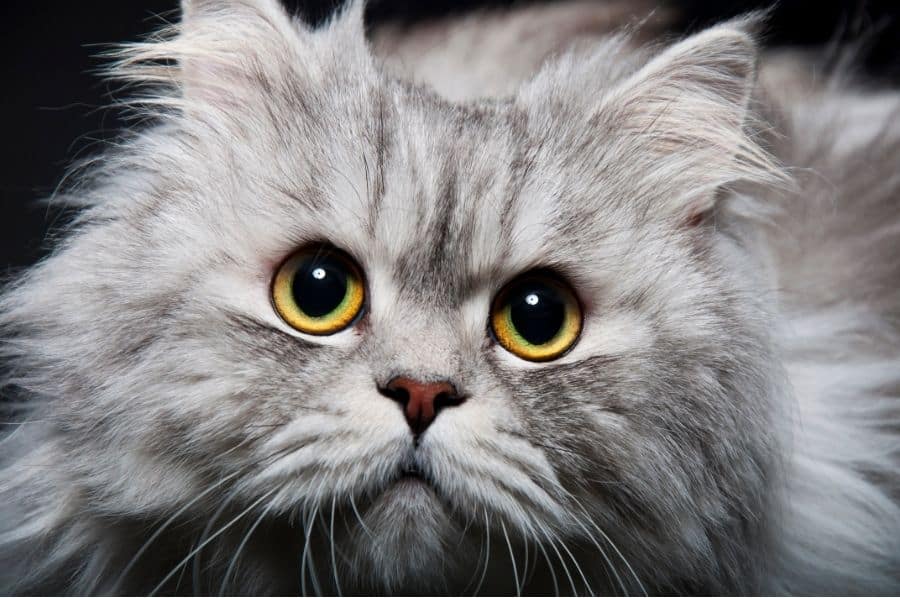More Meows is an Amazon Associate. As an Amazon Associate we earn from qualifying purchases. We may also earn commissions if you purchase products from other retailers after clicking on a link from our site.
Persian cat owners will tell you: these cats are loving, sweet little furballs and great company. As a Persian cat owner, the last thing you want is for your furry friend to suddenly feel ill. Vomiting is, unfortunately, something that these kitties may have to do. This doesn’t have to be their life, though, as long as you know the top reasons why Persian cats vomit.
Vomiting is your kitty’s way of saying, “Something is wrong, and I need help!” An owner’s first reaction is to get upset at the mess and worry about their cat. What can you do once the initial clean up is over? Here’s every reason, its cause, and how you can help your little friend in the future.
If you are concerned about your Persian cat vomiting, you should consult a veterinarian. There are five main reasons that your Persian cat could be vomiting. They are:
- Hairballs
- Sinus Problems
- Food Allergies
- Stress
- Underlying Issues
The Persian Cat Hairball
If there is one thing people attribute to cats, it’s hairballs. Cats are very invested in their grooming habits. If an owner has ever been privy to kitty kisses or licks, they can tell you a cat’s tongue is very rough. According to PBS.org, a cat’s tongue has papillae, which are like little bristles made of keratin, all along their tongue. A cat’s papillae are designed for eating and cleaning!
What does this have to do with hairballs? Cats use their tongue to brush through all their fur, and naturally, loose fur can collect on their tongue, entering into their gastrointestinal tract. Over time, these collect, leading to a hairball. Cats then typically vomit it out to get the buildup free from their stomachs.
Persian cats are prone to these due to their luxurious coats. The same beautiful, thick, long fur that makes these cats so treasured can cause these issues, especially since they shed so often. While common in all cats, a Persian kitty may have it happen more frequently just from these factors alone.
Speaking of hair on Persian cats, check out our article on if Persian cats have hair or fur to learn more: Click Here.
How to Prevent Hairballs in Persian Cats
While hairballs are common, they don’t have to be frequent. As our understanding and care of cats grow, many different avenues have arisen for you to help your Persian kitty to either pass the hairball easily or to prevent them from happening as much as possible. In what ways can you help your Persian cat?
- Hairball Preventative Food: Check your cat’s food brand to see if they offer a hairball formula.
- Lubricant, Laxative, and other Hairball Products: There are various pastes, treats, and more that are formulated to be tasty and allow you cat relief from hairballs.
- Brushing and Grooming: Your Persian will get the love they are looking for and cleaning at the same time!
We talked about hairballs, but Persian cats can also lose their hair under certain circumstances. To learn more, check out our article on the nine reasons for Persian cat hair loss: Click Here.
Persian Cat Sinus Problems
Just like people, cats can deal with sinus infections too. For Persian cats, it can be especially difficult to deal with. Whether they have a flat face or a bit of a muzzle, they have compressed nasal passages that make sinus infections a big problem. Sinusitis, an inflammation of the nasal passages, can be accompanied by rhinitis, an inflammation of the nose, making it hard for them to breathe.
Signs of a Persian Cat Sinus Infection
According to PetMD, various symptoms can present in your kitty to indicate the presence of sinusitis or rhinitis. If you recognize one or more of these symptoms in your Persian cat, it is best to go to your vet to have them identify the best course of treatment. Some symptoms to look out for are as follows:
- Discharge or Mucus
- Loss of appetite
- Reverse sneezing
- Sneezing
- Stuffy Nose
Sneezing is something that can happen with regard to the sinuses of a Persian cat. Learn more about if Persian cats sneeze a lot: Click Here.
Persian Cat Food Allergies
Allergies can be a lifelong issue, but they can also develop later in life. An immune response is triggered suddenly that tells the body that it doesn’t want certain elements or proteins within food in the body. It occurs with food that the body has been exposed to previously, and the body takes time to build the response.
For cats, there may be some low key indicators of an allergic response in your Persian cat. Have you noticed your cat itching but haven’t seen any fleas, bugs, or discernable causes? Is there skin inflammation? These signs combined with vomiting could be a serious sign of allergy for your kitty.
What to Do If You Suspect Feline Food Allergies?
Once you suspect allergies, the next step is to confirm the diagnosis and then identify the reaction’s root cause. Your vet will be able to do a thorough check for any external causes, such as fleas or mites that may escape your notice. Once an allergy has been determined as the cause, the vet will then suggest completing a food trial and food challenge.
A food trial is a strict diet that your Persian cat will be put on to see if their symptoms resolve when they stop eating their old food. If your cat’s symptoms resolve, a food challenge is then done, which involves placing the cat back on their old food. If the symptoms resurge, then it is confirmed they have an allergy, and your vet will indicate what to do for a new diet.
Persian Cat Stress
When calling to mind the image of a stressed cat, we think of the typical Halloween scared post, or a hunched down, ears back, hissing sputtering mess of fur. However, both of these images are just one or two types of stress a kitty might deal with. This is called acute stress, which, as it sounds, is more incidental and temporary. It’s a cause and effect response.
The second type is chronic stress, which may start as acute, but can continue and grow over time. Chronic stress can present as hiding, behavior changes, social changes, and even inappropriate urination or defecation. These issues can usually be more subtle and written off as “A cat being a cat” when really they are saying, “I’m not happy and haven’t been for a while.”
Two areas that you might see stress come out in your Persian cat are if you have any dogs in the house that do not get along with her or if your Persian is having hormone issues around mating.
To learn more about if Persian cats get along with dogs: Click Here.
To read our Persian cat mating guide: Click Here.
Help Your Persian Cat Relieve Stress
Persian cats, and cats in general, are not the big mystery that many people consider them to be. They like routine, easy access to food, playtime, and snuggles. They don’t like change. If you have any big life changes, such as a new pet, a big move, or even increased vet visits, it can throw them off.
The good news is there are many things you can do to help relieve your kitty’s stress and get them back to being happy. Some of these include:
- Reaffirm the routine
- Be sure everyone follows the same kitty-rules (i.e., If the cat isn’t allowed on the counter, no one lets her on the counter.)
- Make transitions, introductions, and vet visits as stress-free as possible
- Keep up to date on vet visits
- Set aside time for play!
It is possible you could see your Persian cat scratching your furniture or tearing up your carpet. To learn more about if Persian cats scratch furniture: Click Here.
Underlying Issues
If all other possibilities are exhausted, the final possibility for why a Persian cat is vomiting, and the scariest, is that there is an underlying health issue they are trying to alert you about. Cats are great at communicating with their body language and vocalizations, but there is no specific “mew” or twitch of the tail that says that your cat is sick.
In fact, when sick, cats tend to try to hide it as much as they can. While it’s kind of them in a way, it can make it exceedingly difficult to identify when a Persian cat is sick until either there is a big display, such as vomit, or an emergency situation. This is why it is so important the moment you find concern in your cat’s behavior to book a vet visit.
Veterinary Visits for Persian Cats
You want your fur baby to be healthy, but at the same time, you don’t want to take them to the vet if nothing is wrong. A good rule of thumb is that if you are concerned, there is no harm in checking. The worst-case scenario in the event your pet doesn’t have anything wrong is that they don’t have anything wrong. That’s far from a losing situation.
With vomiting, it is particularly important to note the frequency. If your Persian is frequently vomiting, a vet visit couldn’t hurt. However, if you notice they aren’t eating or using their litter box at the same time, it is imperative to take them to the vet as soon as possible. This could be a sign of bigger issues in the line.
Conclusion
Your Persian cat is your furry little friend. You don’t want them to suffer or feel ill. If they are vomiting, try to see if you can identify the root cause from the above five reasons. Remember that the vet is always there to help keep your cat in its best health so that you can spend cuddle filled years together.
If you enjoyed this article, check out a couple more articles on Persian cats:
- How to clean Persian cat eyes: Click Here.
- Here’s why Persian cats meow a lot: Click Here.


